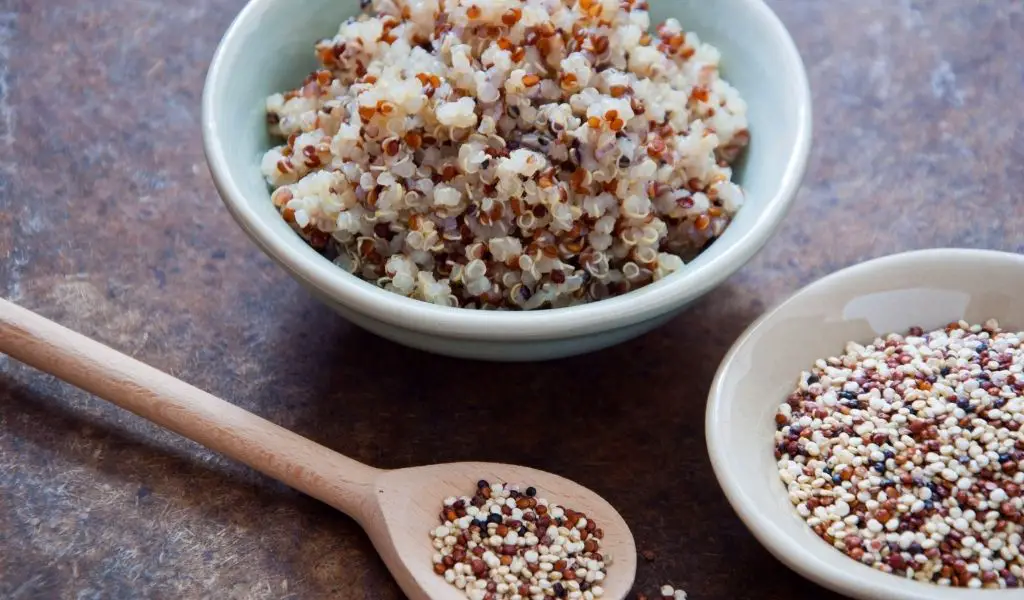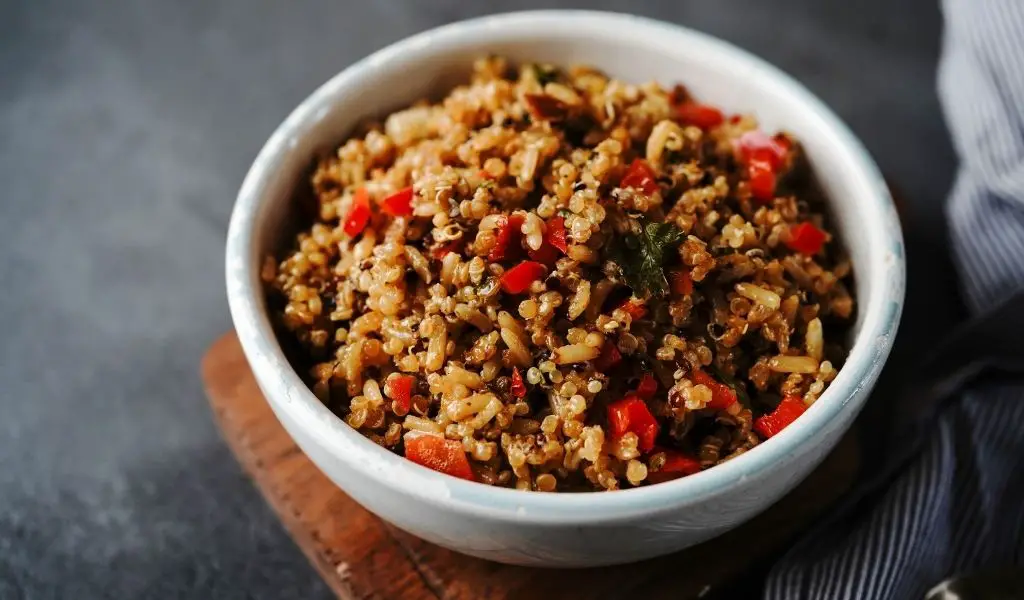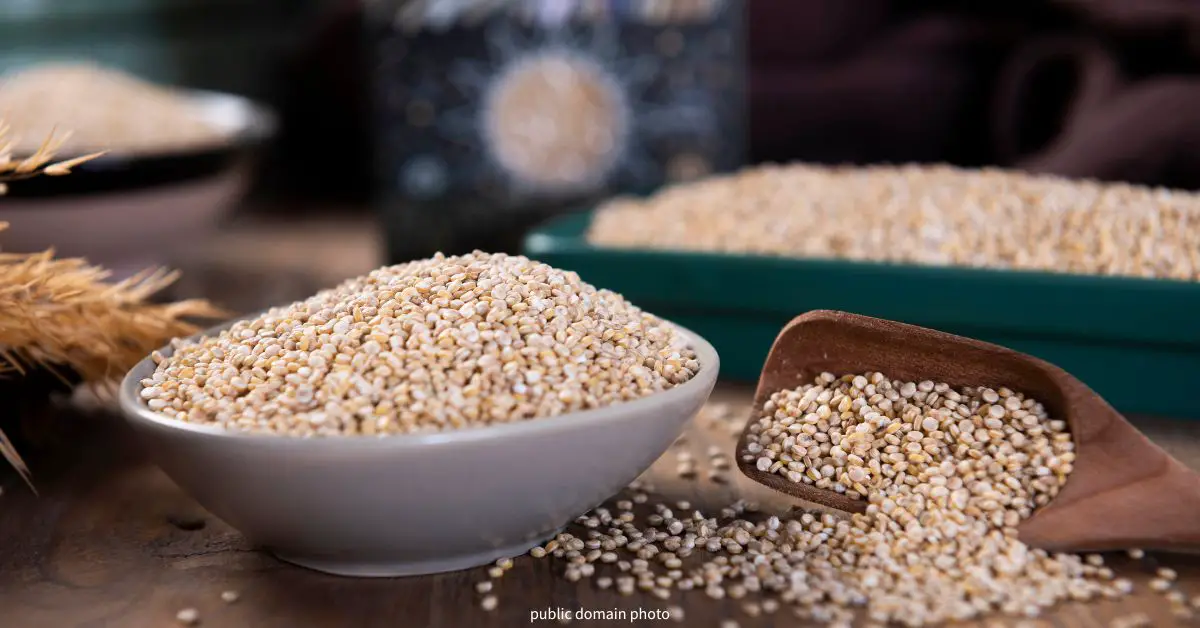Picture a super seed that’s often referred to as a grain. It’s not just a pantry staple but a nutritional powerhouse, and you’ve got quinoa in the spotlight. But if you have histamine intolerance, you might ask the question, is quinoa low histamine?
Short answer: Quinoa is a low-histamine food! You can feel good about working it into your diet since it’s unlikely it to worsen histamine intolerance symptoms. And it’s a nutritious substitute when you need to avoid grains like wheat or gluten.
I think quinoa is delicious – it’s has a delicate nutty flavor and a nice rice-like texture. So, you can basically use it anywhere you’d typically use rice, but without aggravating allergies or sensitivities.
It’s super versatile too – throw it in salads, make it into porridge for breakfast, stuff veggies with it – lots you can do to work that anti-inflammatory goodness into your meals! But let’s dig a little deeper.
Are There Histamines in Quinoa?
Quinoa is generally considered a low-histamine food. The reason quinoa doesn’t set off histamine issues is it’s an unfermented, gluten-free grain. It doesn’t go through the natural fermentation process that so many foods do – which is important, because fermentation can skyrocket histamine.
Quinoa also doesn’t contain the compounds that usual allergy culprits like wheat and dairy have. And since it’s considered a whole grain, it skips complex processing and aging where histamine often builds up.
Basically, quinoa gets to avoid all the usual triggers that can turn other healthy stuff into histamine bombs! It grows, it’s harvested, it’s cleaned – and that’s pretty much it. Quinoa is also not a common allergen, although it is possible to be allergic to quinoa.
So, in summary, multiple studies have confirmed that quinoa is a low-histamine food that is unlikely to provoke adverse reactions in people with histamine intolerance or allergies. Its minimal histamine content makes it a good grain choice for a low-histamine diet.
However, those with severe histamine intolerance should still exercise caution and monitor their reactions when introducing new foods like quinoa.

Does Quinoa Contain Other Biogenic Amines That Could Affect Histamine Intolerance?
Histamine is only type of a biogenic amine, but there are others that you might be sensitive to if you have histamine intolerance. Fermented foods may contain substantial quantities of biogenic amines that can cause reactions in some people.
For example, fish, wine, dairy products, and meat may contain biogenic amines that trigger symptoms similar to histamine intolerance in some people.(1) Plus, these foods may also contain histamine.
Since quinoa is not a fermented food, it’s not known to contain significant quantities of biogenic amines. Therefore, quinoa is not usually a problematic food if you have histamine intolerance.
Now I should throw out a disclaimer – quinoa can cause major allergic reactions for some folks. It’s uncommon, but the proteins in quinoa can be triggers for inflammation and histamine overload if you’ve got an existing allergy. There are even some legit scary cases of full blown anaphylaxis from eating it! (5, 6)
So even though quinoa skips most of the usual allergy culprits like gluten and whatnot, its own proteins can set off immune reactions.
Bottom line – quinoa gets the green light for most people as a low-histamine food. But if you’ve reacted poorly to it in the past, steer clear! No food, even the healthiest ones, are worth an ER trip.
Keep listening to your body and avoid any ingredients that set off flare ups or reactions for you specifically. Everyone has their own unique sensitivities, so personal experience trumps general advice. (2, 3)
The best way to know how you respond to quinoa is to keep a food diary. After working with clients with histamine intolerance and studying their food diaries, most tolerate quinoa without trigger histamine intolerance symptoms. But you won’t know how your body responds unless you can correlate what you eat with your symptoms.
Quinoa is Low Histamine and Nutritious
Beyond its low-histamine content, this mighty seed contains a full arsenal of essential amino acids, making it a rare complete plant-based protein. With each fluffy, forkful you get a powerful 8 grams of protein and all the muscle-building lysine, methionine and cysteine lacking in most veggie fare.
But quinoa doesn’t just excel at protein. It packs nearly 5 grams of fiber per cup to keep you feeling full and aid digestion. It also provides an antioxidant and anti-inflammatory punch from beneficial compounds like quercetin and kaempferol. And it delivers a host of minerals like magnesium, iron, and manganese to keep your body energized and nourished.
Quinoa also contains bioactive compounds with antioxidant activity. (4) The anti-inflammatory and antioxidant activity of quinoa could be beneficial for histamine intolerance.
Beyond all that, quinoa has a low glycemic index to help maintain steady blood sugar levels. It is naturally free of gluten. And studies suggest it may lower cholesterol and triglycerides too.
So don’t underestimate this tiny seed. With its stellar nutritional profile, quinoa stands in a nutritional class all its own. No wonder it’s been a treasured food source in South America for over 5,000 years.
White Quinoa vs. Red Quinoa: Does Color Affect Its Histamine Content?
You can find quinoa in various shades of white, red, and black. There’s no evidence that the color of quinoa affects its histamine or biogenic amine content. However, darker colored quinoa, red or black, has higher levels of antioxidants. (5) Since antioxidants also have anti-inflammatory activity, choosing red or black quinoa may offer added health benefits. (5,6)

Make a Low-Histamine Quinoa Salad
Let’s cook up a refreshing low-histamine quinoa salad! I love this recipe when I want something tasty but gentle on my system. This is a delicious and nutritious option if you have histamine intolerance.
First, rinse some quinoa and then simmer it for 15 mins or so in lightly salted water until it’s fluffy and the water is absorbed. You can throw in some parsley or garlic to jazz it up. While your quinoa is cooking, chop up the veggies – cucumber, bell pepper, whatever you like! I also add olives for a briny bite, but skip if you don’t do well with those.
When the quinoa is done, stir everything together in a big bowl while it’s still nice and warm. This helps all those yummy flavors soak in. Then give it splash of olive oil for richness and a sprinkle of salt and pepper. Taste to make sure the seasoning is popping.
Let everything chill for a bit so the textures and tastes blend. I like making this salad ahead since the ingredients always seem to come together even more over time. When you’re ready for a soul-and-gut satisfying meal, dig into this bright, nourishing salad! Feel free to switch up the veggies depending on what you have on hand or what’s in season. A tasty low-histamine meal awaits!
References:
1. Doeun D, Davaatseren M, Chung MS. Biogenic amines in foods. Food Sci Biotechnol. 2017 Dec 13;26(6):1463-1474. doi: 10.1007/s10068-017-0239-3. PMID: 30263683; PMCID: PMC6049710.
2. “Anaphylaxis to quinoa – Annals of Allergy, Asthma & Immunology.” 19 Nov. 2012, https://www.annallergy.org/article/S1081-1206(12)00820-4/fulltext.
3. Skypala IJ. Food-Induced Anaphylaxis: Role of Hidden Allergens and Cofactors. Front Immunol. 2019 Apr 3;10:673. doi: 10.3389/fimmu.2019.00673. PMID: 31001275; PMCID: PMC6457317.
4. Pathan S, Siddiqui RA. Nutritional Composition and Bioactive Components in Quinoa (Chenopodium quinoa Willd.) Greens: A Review. Nutrients. 2022 Jan 27;14(3):558. doi: 10.3390/nu14030558. PMID: 35276913; PMCID: PMC8840215.
5. Ong ES, Pek CJN, Tan JCW, Leo CH. Antioxidant and Cytoprotective Effect of Quinoa (Chenopodium quinoa Willd.) with Pressurized Hot Water Extraction (PHWE). Antioxidants (Basel). 2020 Nov 11;9(11):1110. doi: 10.3390/antiox9111110. PMID: 33187302; PMCID: PMC7697190.
6. Piñuel L, Boeri P, Zubillaga F, Barrio DA, Torreta J, Cruz A, Vásquez G, Pinto A, Carrillo W. Production of White, Red and Black Quinoa (Chenopodium quinoa Willd Var. Real) Protein Isolates and Its Hydrolysates in Germinated and Non-Germinated Quinoa Samples and Antioxidant Activity Evaluation. Plants (Basel). 2019 Jul 30;8(8):257. doi: 10.3390/plants8080257. PMID: 31366118; PMCID: PMC6724106.


